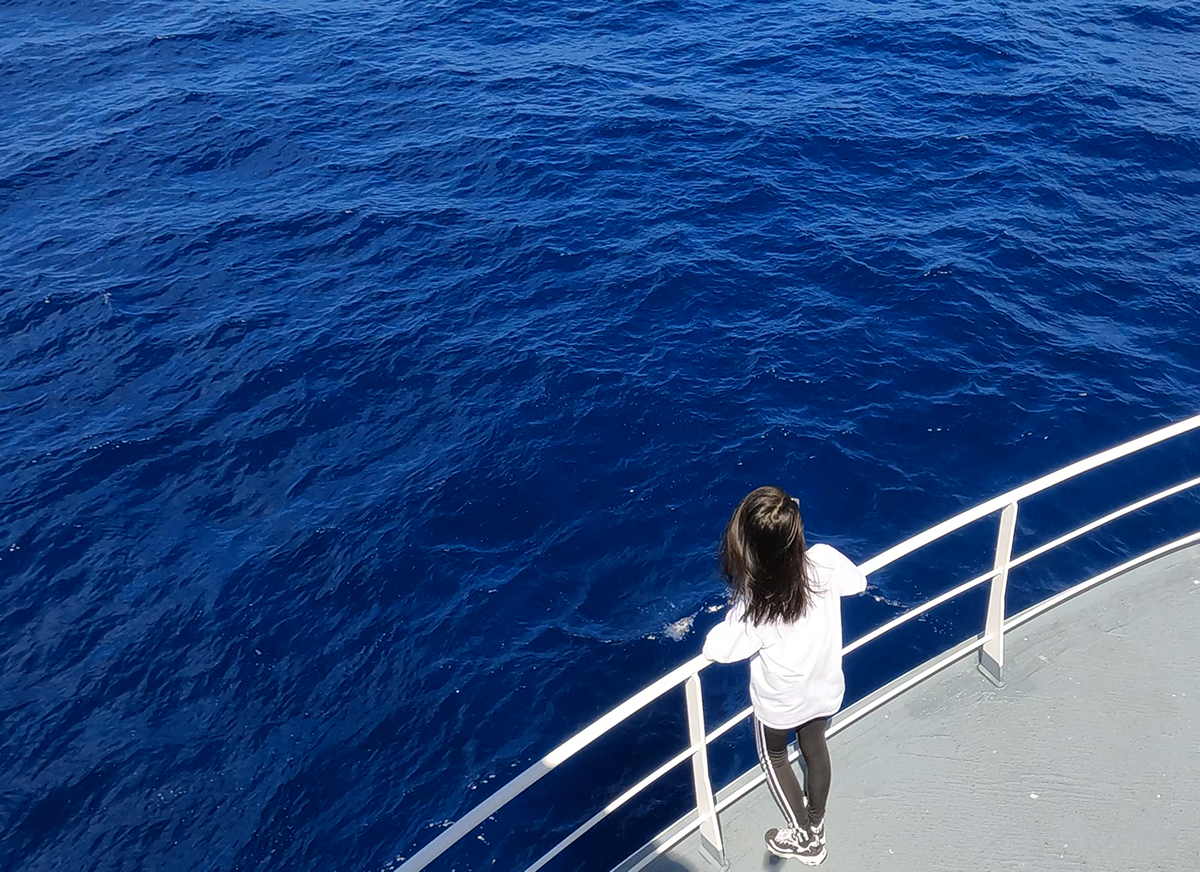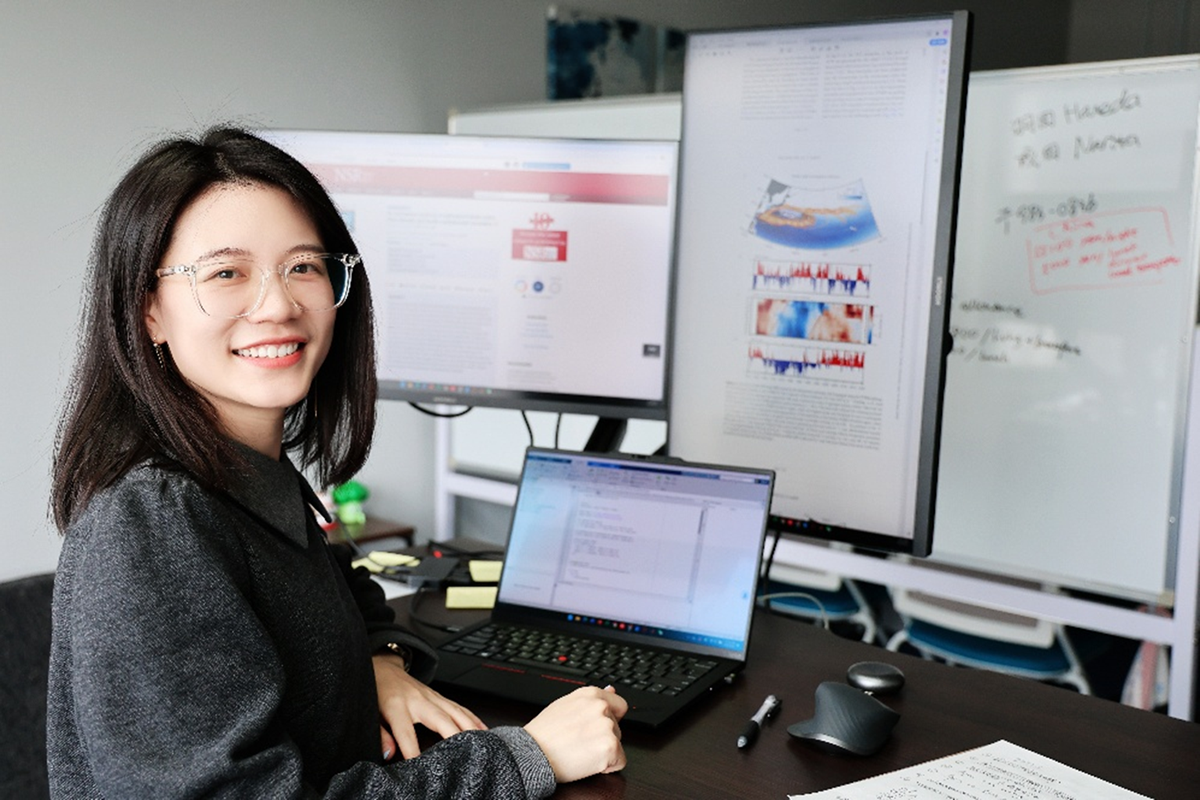Contents

Cutting Edge
2025.8.19
The Ocean Has a Memory: An Oceanographer’s Path to Exploring How the Atlantic Influences the Pacific
How can the Pacific Ocean “remember” signals from the Atlantic and act on them years later? This fascinating question lies at the heart of a recent study by Prof. Baolan Wu, a physical oceanographer whose research uncovers a link between two of Earth’s major ocean variability patterns. In this interview, Prof. Wu shares her journey into ocean science and discusses the findings of her recent paper, “Re-emergence memory of subtropical mode-water links Atlantic and Pacific multidecadal variability”.
―What led you to becoming a physical oceanographer?
I grew up in Qingdao, a coastal city in China where the ocean was one of the greatest joys of my childhood. Over time, I developed a quiet but enduring connection with the sea, something deeply personal and grounding. This affinity led me to major in marine science as an undergraduate and later pursue a master’s degree in physical oceanography. Like many students, I struggled with the decision of whether to continue beyond a master’s. The turning point came during my second year, when I joined a research cruise in the Pacific Ocean. I remember stepping out of the cabin and seeing the vast, deep blue ocean stretching endlessly in every direction. It was breathtaking and profoundly moving. In that moment, I made a promise to myself: I will do everything I can to experience, understand, and protect this beautiful blue ocean. That experience gave me clarity and purpose. It inspired me to continue to a PhD and dedicate myself fully to ocean science.
―That sounds like a fantastic opportunity – what was your master’s research topic?
I had to choose between two research paths, either focus on the South China Sea or the Kuroshio current (a major western boundary current that transports warm water northward along Japan’s Pacific). I’ve always been drawn to the open ocean, so I chose the Kuroshio project. My research started with studying oceanic fronts (boundaries between water masses), such as the Kuroshio and Oyashio Extensions. The Oyashio is a cold, nutrient-rich current flowing southward from the subarctic region. As I continued into my PhD and postdoctoral research, my focus expanded to the ocean’s mixed layer south of these fronts, and later to the North Pacific Subtropical Mode Water. Step by step, my research has evolved to explore basin-scale interactions and the interplay between the open ocean and marginal seas. Looking back, it’s been a gradual and deliberate journey, each stage building on the last to form a coherent, systematic body of work.

―What exactly are mixed layers and mode waters?
The mixed layer is the upper part of the ocean where water is stirred by wind, waves, and surface currents, making it quite uniform in temperature and salinity. Because it’s the part of the ocean that interacts most directly with the atmosphere, the mixed layer plays a key role in weather, climate, and marine ecosystems. Beneath the mixed layer, in certain regions and seasons, another special type of water forms, called mode water. These are thick layers of water with nearly uniform temperature and density, often created during winter when cold, dense water sinks just below the surface. Mode waters can store heat and other properties for years and influence how the ocean circulates and exchanges heat with the atmosphere over long time scales.
―What were you trying to understand about the ocean in your most recent study?
One fascinating thing about the ocean is that it can hold onto heat for a long time, sometimes for years, whereas the atmosphere responds much more quickly and can’t retain those signals over long periods. This ability to “store” past climate signals (e.g. temperature anomalies) is the so-called “ocean memory”. We wanted to understand how two major patterns in long-term ocean temperature variability are connected – the Atlantic Multidecadal Oscillation (AMO) and the Pacific Decadal Oscillation (PDO). Scientists have noticed that changes in the Atlantic (AMO) tend to be followed by similar shifts in the Pacific (PDO) about 12 years later. We wanted to understand why that delay happens and what physical process allows the Atlantic to influence the Pacific over such a long-time scale. Our goal was to uncover the ocean mechanism that connects these two distant basins through memory and time.
―So, did you discover what is causing the lag?
Yes, we did. We found that a specific water mass in the Pacific, called subtropical mode water, plays a key role in storing and transferring climate signals from the Atlantic. Changes in Atlantic temperatures (AMO) can influence atmospheric pressure patterns across the globe. These changes send a signal across the Pacific through what scientists call a stationary Rossby wave, a large-scale atmospheric wave pattern. This then alters the wind patterns over the western Pacific, where the subtropical mode water forms. As a result, the temperature anomalies triggered by the Atlantic become embedded in this water mass. Once formed, this water mass travels along the “recirculation gyre”, a large, slow-moving, looping current system in the ocean, and eventually feeds back into the Kuroshio system about a decade later. This mechanism helps explain how the Atlantic can influence the Pacific with such a long delay. It’s like the ocean carrying a climate message across time and space, delivering it years later and linking the variability of these two distant ocean basins.

helping improve theoretical understanding of what causes shifts in climate.
―How did you uncover this mechanism? What tools or data did you use?
First, we analyzed three-dimensional ocean data to map the spatial structure of subtropical mode water, showing where it forms and how it changes with depth. Another key method we used is Lagrangian tracking, which simulates the movement of water over time. It’s like releasing thousands of virtual floating objects into the ocean and watching where they go. This helped us trace the exact pathway the mode water takes across the Pacific. Because we were studying interactions between two different ocean basins over decadal to multidecadal timescales, we needed datasets that were both global in coverage and long in duration. So we used three observational datasets that span about 80 years, and one ocean reanalysis dataset that extends back 140 years.
―You used both observational data and computer models – is one alone not good enough?
Observational data is essential because it shows what actually happened in the real world, it’s the foundation for all climate studies. But the ocean is vast, and observations don’t always cover every region or go back far enough in time. That’s where computer models come in. To explore long-term patterns and test our ideas, we used global climate simulations to dig deeper, including a pacemaker experiment model simulation. A pacemaker experiment is a type of climate model simulation where a specific region’s sea surface temperatures (SSTs) are artificially fixed to observed values to see their influence on the broader climate system. In our case, we introduced a warm or cool phase of the SSTs in the Atlantic (i.e. AMO) and analyzed how the Pacific reacted. This helped us isolate and understand the cause and effect. When the results from the observations, the long-term models, and these pacemaker experiments all line up, it strengthens the validity of our findings. This gives us greater confidence in predicting climate shifts for years, or even decades, in advance.
―Why is it important to be able to predict climate shifts decades in advance?
Just like weather forecasts help us plan for the week ahead, long-term ocean and climate predictions can guide how we manage the ocean’s health and resources. More accurate forecasts can improve decisions about fisheries, marine ecosystems, and coastal planning – all of which are deeply connected to our daily lives. Right now, many ocean models still struggle to predict changes in key regions like the Northwest Pacific, where large climate variations occur. Our study helps improve the theoretical understanding of what drives those changes. By identifying the physical mechanisms behind long-term climate shifts, we can work toward more reliable ocean predictions not just for tomorrow, but for the next decade.
―What do you want to understand about the ocean next?
In recent years, the extreme marine heatwaves off the coast of northeastern Japan have caused severe damage to marine ecosystems and local fisheries. But we still don’t fully understand the dynamics behind these events, which makes it hard to predict the next one. In my current project with the Scripps Institution of Oceanography, we’re investigating the underlying mechanisms that drive these extreme heatwaves. We’re focusing on the role of remote influences, climate signals coming from the tropical Pacific and North Atlantic. Often overlooked in past studies, these remote influences may be key to forecasting future marine heatwaves. By uncovering these long-distance connections, we hope to improve early warning systems and help protect the ocean and the communities that depend on it.
Interview
Nadine Wood, Specially Appointed Associate Professor (Management), Tohoku University
Links
Paper (published on February 14, 2025, in the scientific journal “National Science Review”)


